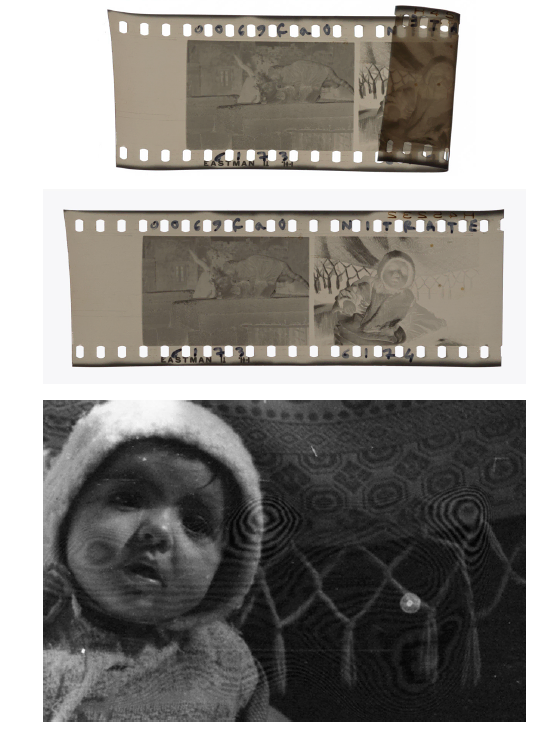Since the establishment of its in-house (AIF) digitization project in 2010, the Arab Image Foundation has been engaged in the accurate color and tone reproduction of its collection of photographs. In recent years, the digitization has been led using the Epson Expression 10000XL flatbed scanner. The AIF digitization standards include the scanning of all photographic objects in their entirety, without cropping any of their visible parts, be it a frame or border. While for most print materials, the scanner itself has been able to hold the object flat and in place, it became more challenging for film negatives that exhibit curling. A film holder is a common solution, but it wasn’t an option for us because it cropped out the borders of the negative, whereas using a clear glass sheet to hold the negative down solved both concerns, but created a new issue: Newton’s rings.

Middle: Scan of the same film negative, held down to the scanner bed using a clear glass sheet.
Bottom: Detail of the image exhibiting Newton’s rings while using the glass sheet.
Newton’s rings have been nuisance for photographers ever since the darkroom. As Ansel Adams noted in his book The Print, Newton’s rings “are concentric rings of irregular shape that resemble the iridescent patterns of an oil slick on wet pavement. They are caused by the interference effect of light reflecting within the extremely small space between the glass and the negative base.”
In our case, the close proximity of two smooth surfaces – that of the glass and of the negative – resulted in these visible rings, and the team started to look into introducing another glass weight, with a matte finish, to solve the problem. Using the Tru Vue Reflection Control® Acrylic sheet, we were able to produce a flat and clear scan, with no visible Newton’s rings at all. Additionally, unlike other non glare sheets with an etched surface, the Tru Vue sheet didn’t leave a visible texture on the resulting scan.
Rima Mokaiesh, Arab Image Foundation Director, noted, “The Arab Image Foundation values its partnership with Tru Vue immensely. They have been wonderful supporters of our work, and more broadly of museums, art institutions, and preservation initiatives in the region. We were absolutely delighted to find a creative way of using their cutting-edge products in our work on negative collections.”

Middle: Placing the Tru Vue Reflection Control® Acrylic over the film negatives to scan.
Bottom: Ideal order of layers inside of the scanner – 1) Scanner
transparency unit; 2) Tru Vue Reflection Control® Acrylic sheet; 3) Film negative, emulsion side down; 4) Scanner bed.
Share this Article:
This article is intended for educational purposes only and does not replace independent professional judgment. Statements of fact and opinions expressed are those of the author(s) individually and, unless expressly stated to the contrary, are not the opinion or position of Tru Vue or its employees. Tru Vue does not endorse or approve, and assumes no responsibility for, the content, accuracy or completeness of the information presented.
